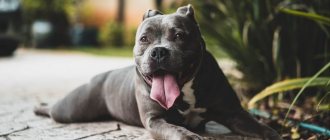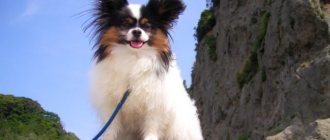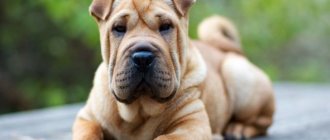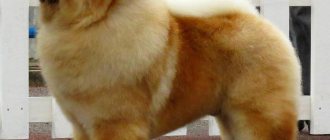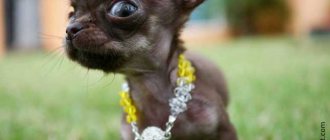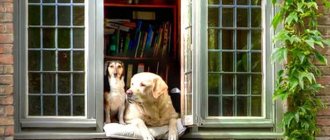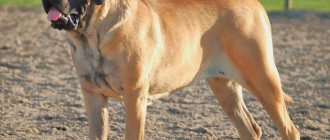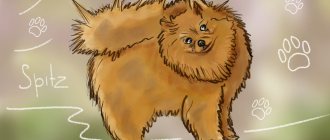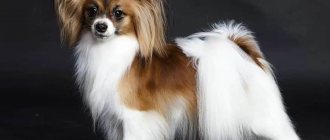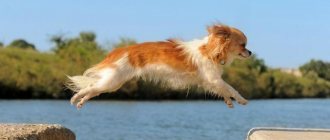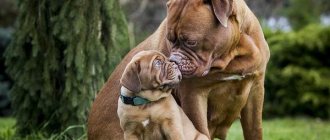Each of us knows that a dog is a faithful friend, helper, and sometimes even a protector. There are more than 400 species in the international register, divided into different categories.
Animals are divided by height, weight, temperament, character and tactics in battle. In our article we have prepared material about the twenty most powerful dogs in the world. We will prove with facts their power and endurance, and also briefly describe the history of origin, the main features and skills that distinguish the breeds from each other.
Saint Bernard
The history of the development of this breed began in the distant 17th century, when the monarchs of the monastery of St. Bernard needed to save local residents during an earthquake. This is where the name of the famous breed came from. These “rescuers” had to dig people out from under piles of snow, and sometimes walk 3-4 kilometers to deliver the wounded to rescuers.
The dog's height reaches about 80 centimeters at the withers, and the weight category is also impressive - from 55 to 90 kg.
Pet appearance:
- Brown, less often black, sometimes spotted;
- The feet are usually white;
- The body and limbs are massive.
Despite their menacing appearance, St. Bernards are affectionate and get along very well with children and small pets.
Newfoundland
The island of the same name in Canada has been considered the historical homeland of this breed since the 17th century. Even then, the strength and endurance of this dog when fishing was highlighted. Often the dog helped catch drowning people and pull them to land, so it was awarded the nickname “diver.”
It is important for a Newfie to be needed by his owner and those around him who are in trouble. Often, “giants” serve in the police and work as guides. The pet needs affection and care, despite its impressive size, do not use rough tactics when raising it.
Weight characteristics are about 70 kilograms, height at the withers can be equal to 70 cm. It occupies an honorable place in the list of large breeds in the world.
Let's see what a Newfoundland looks like:
- Black color, sometimes transitioning to a more bronze shade is possible.
- Large body with lots of fur.
- In appearance there are similar features to a bear.
Where to channel your dog's strength and endurance?
The strongest dogs perform well in protecting the owner and territory, as well as in cynological sports. In the first case, the main role is played by impressive dimensions, muscles and territorial instinct.
When participating in dog sports, the requirements for four-legged dogs depend on the type of discipline chosen. Whitepulling, coursing, skipulling, skijoring, canicross, bikejoring and sled dog racing require endurance and teamwork. When choosing agility, flyball, dog frisbee and freestyle, the most important thing is artistry and intelligence, which allows you to master different tricks and the order of passing the obstacle course.
Do you like the article? 210
Boerboel
Certain areas of South Africa are considered to be the breeding ground for this breed. A distinctive feature of dogs is their strength and endurance in hot climates. The Boerboel has a rebellious disposition, so they can only be tamed by a strong and powerful person, in whom they recognize authority.
The height of adult dogs of this breed can be 61-70 centimeters. It can weigh approximately 60-85 kilograms.
Appearance:
- Massive skeletal frame and muscle layer.
- Large and heavy figure.
- Most often they have a brick-red color.
- The coat is short and hard to the touch.
In the absence of proper education and training, they will become bloodthirsty cannibals that nothing and no one can stop.
~Kangal~
The breed is a bit reminiscent of the Central Asian Shepherd, but the Kangal, as illegal fights have proven, is stronger and more resilient.
The size of the animal is terrifying, which makes it an excellent watchman and security guard.
Tags
Alabai Bull Terrier Doberman Kangal Perro de Presa Canario Pitbull Rottweiler The most powerful and dangerous dogs in the world Central Asian Shepherd Staffordshire Terrier Tosa Inu Fila Brasileiro
Rhodesian Ridgeback
This relatively young breed appeared as a result of crossing domesticated and “tailed” hounds at the beginning of the 20th century. Like the previous representative, it has a unique character and ferocious disposition, as a result of which not every owner will be able to get along with such a “beast”.
In African countries, these hunting dogs are highly valued for their strong qualities, so they have become desirable participants in safari. On other continents, dogs help people look after their homes and maintain law and order.
The dog's height reaches about 62-70 centimeters at the withers, the weight category is average - from 32 to 69 kg.
Features of the appearance of an adult:
- Powerful and muscular with a harmonious physique.
- The fur running along the ridge line should grow in the opposite direction.
Reference! Cases have been recorded when this dog was not inferior in bloodthirstiness to a lion. Therefore, a number of countries, for safety reasons, have imposed a ban on the import of representatives of the breed. This fact contributed to the emergence of a second name for the Rhodesian Ridgeback - “lion dog”.
Cane Corso
This dog is a descendant of the fighting dogs of Ancient Rome, which were brought to gladiator fights for greater entertainment. Representatives of this breed are born bodyguards, helping in the service, hunting and in the field.
Cane Corsos have a very cool temperament, but are moderately obedient. The animal is absolutely selfish and cannot stand other dogs. If another dog appears at home, the Cane Corso will strive to defeat its opponent.
The standard weight of a pet is from 40 to 50 kg, and the height at the withers is equal to 60 cm. Quite large “tailed” animals, in size, are in the category with Akita Inu and Leonberger.
Read Top 20 most expensive dogs - for the price of a good car
External data:
- black, gray and red wool;
- pronounced pectoral muscle;
- The surface of the coat is smooth, almost glossy.
Absolute record holders
Naturally strong animals have their own record holders who demonstrate their skills both in everyday life and in sports competitions.
Whippet Wendy - a dog with a mountain of muscles
Surprisingly, the record holder in this event was a dog of the Whippet breed. Wendy was the victim of a genetic mutation that led to uncontrolled muscle growth. Due to the abundance of muscle, Wendy weighs twice as much as the standard. Of course, among other whippets the record holder is the strongest and fastest.
From the outside it may seem that Wendy suffers from such a “disease”. The dog's owner claims that everything is fine with her and Wendy is living a happy life.
St. Bernard Raittes Brandy Bear
Representatives of strong breeds often participate in weight-pulling competitions, a type of canine sport where it is necessary to pull heavy weights. Saint Bernard set a record that has stood since 1978. An 80-kilogram dog was able to drag a load weighing 2905 kg over a distance of more than 5 meters.
Newfoundland Barbara
There is also a “female” record in this area. It was installed by a Newfoundland female in 1979 - Barbara Alens Dark Hans. The Guinness Book of Records considers her the strongest dog in this weight category. She managed to drag the weight (2289 kg) across concrete to a minimum distance (about 4.5 meters). The most interesting thing about the record is that Barbara’s own weight at that time was only 44 kg.
Pitbull Tyson
But a pit bull with an eloquent name became the strongest dog in Europe back in 2004. He was able to drag a cart with a total weight of 385 kg over a distance of 4.8 meters. And he did it without long training and preparation.
Alaskan Malamute Moses
Record holder for hauling loads on natural snow. Moses was able to pull the cart, the total weight of which was 680 kg.
Mastiff Riddle
The International Association of Weight Pulling for Dogs conducts tests in various categories - the mastiff Riddle became the record holder for pulling a loaded cart on artificial snow. The weight he took was 1215 kg. The record has stood since 1998.
Rottweiler Budel
The female Rottweiler holds the title of the largest representative of the breed. She weighs more than 95 kilograms . The Bewdel is known in England as the fattest dog.
American Bulldog
This breed can be called the standard of power and dignity. The history of origin dates back to the 18th century. At that time, the settlers were engaged in farming in order to protect themselves, they tamed such dogs to protect their homes and nearby territory, and to help drive livestock.
They subsequently developed an instinct to distrust strangers, which has made them the most reliable and loyal defenders to date. The pet’s character is not the most flexible, but if trained from an early age, there will be no problems with obedience.
Amazing fact! In dog fighting, a representative of this breed has no equal and can even kill a bull with his fangs.
Bulldogs are medium in size, so height starts from 50 cm to 70 cm, and the weight category is 28-55 kilograms.
Main features of a dog's appearance:
- Strongly developed jaw muscles.
- Wide chest and large muscular legs.
- The muzzle is square in shape.
- The hard wool is white with small black and brown patches.
Tyson
The owner brought a pit bull from Donetsk to the competition, as they say, from the street, without special training. The smart and kind dog won the load tug, and today he is the strongest dog in Europe.
So we found out which dog breed is the strongest. But, being strong, they remain loyal and friendly.
Dogs of any breed, no matter what qualities and strength they possess, deserve respect and admiration. After all, dogs have been protecting people for more than 10 thousand years, helping in social and economic life, performing military service and saving people during natural disasters.
Author of the article: Valery Skiba
Alabai
The regions of Central Asia are the birthplace of this pet, where it acquired its second name - the Central Asian Shepherd Dog. This dog has a rich history of origin, dating back 4000 years ago, when representatives of the breed protected nomadic shepherds and their herds.
The dog has a sharp mind and intelligence, and is calm in various situations. He approaches his duties in the service of a person very responsibly (in security activities at work and at home), if he is regularly trained. Can sometimes be stubborn. Be careful when raising your puppy, do not use force, otherwise this may lead to the development of aggressiveness. Adults like to warn their owner about the presence of a stranger by barking.
Height parameters are 65-79 cm, weight minimum 40 kg, maximum 80 kg.
Alabai's appearance:
- Proportional physique and powerful muscles.
- Well developed chest.
- Hard and dense wool of black, brown, gray and brindle colors. Often, several basic shades of the palette are combined.
Features of powerful dog breeds
All these animals are large in size and heavy in weight. Their jaws are powerful and their grip is very strong.
When purchasing a representative of this breed, it is worth remembering that he needs proper and high-quality training. That is why people who do not have experience with such dogs should not take risks. Without proper training, these dogs can become aggressive and dangerous to society.
The main feature of such pets is devotion to the owner and the desire to protect him. A well-mannered dog will never rush at a stranger without a reason. She only attacks if she senses a threat.
English Mastiff
The ancient English breed dates back several thousand years BC. In Ancient Babylon, they helped hunt wild animals, and even predators.
In practice, they regularly proved their loyalty and devotion. Almost all “tailed animals” of this category have a strong bodyguard instinct from birth. Over time, dogs have ceased to consider protection as the main purpose of their life, however, their low timbre of barking will definitely scare off a stranger.
Truly gigantic dimensions: weight - from 80 to 90 kilograms, height at the withers - approximately 75 cm.
What does a mastiff look like:
- A large individual with a wrinkled muzzle.
- Short, close-lying coat.
- The color scheme can be varied:
- The head is quite large compared to the body.
Akita Inu
Historically confirmed facts of the breeding of this breed appeared approximately 8000 years ago in Japan. At that time, people adhered to hunting traditions and found use for such a dog there. Akita was also able to protect the house and the surrounding farm in turbulent times: in conditions of constant raids.
She is the largest dog in the Spitz category. She doesn't bark for no reason, so you should listen to her protective instincts.
External data:
- Red-fawn, white or brindle color.
- The ears are raised up, with rounded tips.
- Strong build, but light weight 30-40 kg and tall height - 65-71 cm.
- Developed muscular frame.
Treats each family member with love, with the exception of other pets, in whom he sees a rival.
Rottweiler
Rottweil, located in the southwestern part of Germany, is considered the city of origin of this breed. Dogs were used there as carriers and guards. After which, the four-legged guards received their “salary” - meat products.
Rottweilers are the best rescuers who are willing to risk their lives in order to save human life. They are distinguished by their intelligence, observation and lightning-fast reaction if a threat arises. They are often brought in as guide dogs.
At home, these animals change their behavior, becoming lazier and more affectionate.
The standard height is 59-70 centimeters, length at the withers is 117-137 cm.
Among the outstanding external features of the pet are:
- The color is black with brown and brick markings.
- Their body type is prone to obesity, so your pet needs to be fed properly and maintained an active lifestyle.
- Has large dimensions and toned muscles,
- Showing interest, small folds and wrinkles appear on the dog’s face.
Read Short-legged dogs - top 20 breeds
Leonberger
At the end of the 19th century, in the German city of Leonberg, the head of the municipality wanted to create an unusual symbol of the city - a lion dog. As a result, we managed to cross several species (Sernbernar, Newfie and Large Pyrenean dog) to get the desired color.
The dog is an unsurpassed guard who, without grinning or excessive aggression, will scare away a person who has encroached on someone else's livestock or property. Thanks to their keen hearing, strength and endurance, they make excellent guide dogs, shepherds and companions.
The approximate weight category is from 40 to 75 kg, the length at the withers is no less than 65 and no more than 85 centimeters.
Appearance features:
- Like a lion, the dark color of the face is combined with bright red fur throughout the body. White-gray color is also possible.
- Large build with powerful paws.
- Long ears hanging down to the cheeks.
- This is a long-haired animal that requires special care.
Staffordshire Terrier
The history of the breeding of this individual began around 1700 when bulldogs were crossed with terriers. After fierce battles in England, aggressiveness and rabies began to be observed in this species, so people still have the impression that the Amstaff is a cruel and bloodthirsty killer, but this is far from the case.
Excessive aggression is associated with a vague pedigree. A “clean” fighting dog will be able to protect its owner without fear or reproach. She senses danger on a subconscious level.
Despite their massive size, terriers are active and agile to serve as watchdogs. A distinctive character trait of such a dog is the inability to get it angry. Dogs adore children, so they can act as a companion and loyal friend.
The height is quite small - 45-59 cm, weight is equal to 30 kg.
Appearance of this breed:
- Stocky and strong body with a powerful head and neck.
- Ears set high and sticking up.
- The massive jaws have a death grip.
- The color standard can be: black, brown, red, brindle. A combination of the listed shades is possible.
Pitbull
The truth is that "pit bull" is not technically a breed of dog, but rather a term used to refer to a variety of related dogs, such as the American Pit Bull Terrier, Staffordshire Bull Terrier, American Bulldog, and many others. Due to varying, unregulated breed standards in dog registries, as well as an unfortunate overabundance of “backyard breeding,” it is very difficult to establish one true standard for the Pit Bull.
Pit bulls are known to be sweet family companions and are easy to train and adapt to family life with proper socialization. But it is worth considering that the pit bull has a strong-willed character. He requires regular physical exercise and mental stimulation.
Siberian Huskies
These fluffy beauties will not be able to help a person on a hunt, nor will they protect the house from burglary, however, their complex work is worthy of admiration. There is an assumption that the breed was bred by nomadic tribes in the 20th century to overcome huge distances across the snow-covered expanses of Siberia.
Now dogs are used as a carrier of heavy loads in harsh northern conditions, but many owners get and try to domesticate such pets.
Their main feature is the need for physical activity and an active lifestyle (walking at least 7 hours a day). Therefore, if you are not ready to devote so much time to your husky and like to be lazy, then you should not buy it.
The weight of adult individuals is about 20-27 kg, and the height is from 50 to 58 centimeters.
Let's describe modern husky standards:
- Strong, proportional build, deep chest, straight limbs.
- High-set ears that give a slight resemblance to wolves.
- Thick coat that can withstand sub-zero temperatures.
Alaskan Malamute
Another sled dog that can withstand extreme arctic conditions. The animal has incredible strength and endurance, because only she transports heavy loads in the north. Therefore, it is often called a heavy-duty dog.
Today, the Malamute can become a loyal and flexible four-legged friend at home.
Height and weight characteristics are 64 cm and 40 kg, respectively.
Let us highlight the following features of the appearance of these “tailed animals”:
- The thick fur resembles a soft plush material.
- Large build with well-developed muscles.
- Triangular ears with a slight rounding.
- Exceptionally dark eye color.
- The color is preferably dark and light gray, white.
In 2010, the Malamute acquired the title of symbol of Alaska, as the personification of this harsh territory.
Tibetan mastiff
In our top list of strong dogs there is a real king of beasts. The origin of this breed is mysterious and enigmatic, since animals appeared long before the emergence of writing in the regions of Tibet.
The first recorded facts concerned the Chinese Emperor Wu, who received as a gift such a trained dog, which was intended for hunting and home guarding. Today, the Tibetan has retained his guard skills, barking loudly when danger arises, preparing for an attack.
Unsuitable for keeping in an apartment due to its huge dimensions. Gets along well with children and some small animals.
Standard height ranges from 55 to 67 cm, and weight is 67-78 kilograms.
The appearance of the mastiff is as follows:
- Thick coat, which makes it difficult to feel the muscles.
- Strong middle limbs and shoulder muscles.
- Muscular neck, there is a slight advantage in the figure.
- Large head and wide wrinkled muzzle.
- Color: chestnut, bright red, brown, black. Possible combinations of several shades on the paws and face.
Such a formidable and majestic breed, at first glance, knows how to show tenderness and awe towards family members, and is capable of sincerely becoming attached to the owner.
Very interesting, and most importantly useful!
Many people, when getting dogs, want, first of all, to feel protected. Large breeds of dogs are best suited for this, capable of instilling fear in others just by their appearance. Having such a friend at home needs to take into account not only the pros, but also the cons, especially for families with children. Large, strong dogs require certain conditions and training. Let's figure out which dog breeds are the strongest in the world, and what their positive and negative sides are.
Page content
20 American Bandog
The Bandog is a family-friendly breed because it loves children and is instinctively protective of them, but can also be a service dog. But he is not an aggressor. But if someone else is playing with the child, the games should not be too active, otherwise the bandog could assess such a situation as a danger. He doesn't get along well with other pets and this also applies to other dogs. The puppy needs to get used to their presence in order to avoid conflicts in the future. He is very distrustful of strangers and wary of them. He is a great guardian of people and property. Proper upbringing and training are very important for this breed and should not be underestimated. If you raise a Bandog correctly, he will be a good friend with whom you will not have to be afraid of anyone, because he will be able to protect you. In addition, he will listen to his master without any problems if he has mastered the training. It may take him a while to learn the commands, but then he won't forget them.
Flaws:
- needs an experienced owner;
- constant need for physical and mental development;
- aggression;
- sensitive to cold.
Advantages:
- has protective qualities;
- hardy;
- smart;
- has good health.
19 Bernese Mountain Dog
The Bernese Mountain Dog has a moderate disposition, is balanced, cheerful and sociable. At a young age he is spontaneous, over time his behavior becomes more stable. He is very attached to his owner and needs close contact, so you should not leave him alone for a long time. The Bernese Mountain Dog is also not suitable for being kept in a pen - it must be able to move freely around its territory and have unrestricted access to the house. This breed tends to be submissive, with females more focused on cooperating with the handler and males more self-confident, which can make them less disciplined.
As a vigilant and observant dog, the Bernese Mountain Dog is a good, quiet watchdog. It is true that it does not guard territory with the same dedication as the Caucasian Shepherd, but it is effective in scaring off intruders. People he knows are usually greeted warmly, he may stay away from strangers but will accept them if their hosts greet them.
Bernese Mountain Dogs Patient and understanding dogs of this breed get along well with children of any age. But leaving them alone or entrusting a child to take the dog for a walk is not worth it due to the impressive size of the pet. The Bernese Mountain Dog usually gets along well with dogs and other pets, although there are exceptions - the source of inappropriate behavior is usually errors in upbringing or an abnormal psyche. The Bernese Mountain Dog is active and energetic. He requires a lot of exercise, but he is not competitive, so hiking would be better than running a bike. An adult dog needs to be walked several hours a day. A bored and uncontrollable Bernese Mountain Dog may destroy objects in the house or dig holes in the garden. Unfortunately, most Bernese dogs are litter pickers. They will also sometimes chase a cat or other animal while walking.
Flaws:
- quite expensive to maintain;
- tends to collect waste;
- does not live long.
Advantages:
- excellent family dog;
- friendly to people;
- loves children;
- a good watchman and security guard;
- smart, easy to train;
- suitable for sports;
- We are tolerant of other animals.
18 German boxer
The Boxer is a brave, confident dog with boundless energy that needs to be controlled. if not raised properly, it may try to dominate the owner. Therefore, consistent training needs to start very early. Boxers are wonderful family dogs and children's guardians. They are full of joy, always ready to play. They can conflict with animals, especially with other dogs, so it is better to avoid ambiguous situations.
Flaws:
- does not tolerate other dogs well;
- requires a lot of exercise;
- some may drool.
Advantages:
- excellent defender;
- calm and balanced;
- child friendly;
- attached to family;
- smart;
- easy to care for.
17 Bulldog (pit bull, American, English, etc.)
The Bulldog is an intelligent, cheerful and sociable dog. Compared to the human character type, he is straightforward and sincere. He doesn't like his family, especially his children. It tolerates other animals well and will live in harmony under the same roof with either a cat, a rabbit or a guinea pig. Doesn't require long walks, let alone running. For these reasons, it is an ideal breed for living in urban environments. Raising a bulldog is not difficult if the owner is consistent. He senses any weakness in the owner's character and uses it to his advantage. Dogs of this breed are extremely attached to their owners and love them immensely. There is absolutely no aggression in them, and they can follow their owner step by step.
Flaws:
- feels unwell under the influence of high temperatures;
- independent and stubborn
Advantages:
- attached and devoted to family;
- shows tolerance towards children;
- loyal to other animals in the house;
- does not require intensive spending time
16 Caucasian Shepherd
They have a strong instinct of ownership, and any intruder who appears on their territory will be attacked and driven out.
In a foreign place they are calm and reserved, but never timid. Excessive aggression is not courage at all, but rather a lack of self-confidence. Caucasians are noisy dogs. They are very vigilant and react to the slightest noise. Calm, it is difficult to unbalance them. At the same time, they are very proud dogs; they have a strong, independent character with a great sense of self-esteem. For centuries they worked independently, protecting herds of domestic animals from wolves and bears. Such work has shaped their personality, and they cannot be expected to completely submit to human will. You need to make friends with such a dog and treat it as a partner, only then will it allow the owner to take a leading position in the herd.
Flaws:
- prone to aggression;
- independent and stubborn;
- Experienced owner required.
Advantages:
- properly brought up, he is extremely devoted to his family;
- an impeccable, incorruptible watchman;
- healthy and resilient;
- economical to maintain (for such a large dog).
15 Doberman
The Doberman is a dog with a decidedly strong character, extremely domineering, which will always try to subdue its owner. From the moment a dog appears in the house, the guardian must seriously engage in its upbringing. It takes a lot of patience, persistence and love to raise him correctly. He does not tolerate harsh behavior, and it will not be possible to force such a dog to do anything. The Doberman is very observant, will notice every weakness of the owner and will try to extract privileges from it for himself. The Doberman is very affectionate and devoted to his family. But you shouldn’t expect complete obedience and obedience from him.
Flaws:
- an experienced owner is needed;
- requires consistent control;
- tends to dominate.
Advantages:
- guard dog;
- vigilant guardian;
- very attached to his owners;
- brave and faithful;
- hassle-free care
14 Estrela Shepherd Dog
This is a very hard working dog, extremely brave and incorruptible, making it an excellent guard dog. She is extremely vigilant and does not tolerate strangers on her territory. The dog looks like he is lazily resting, but this is only an appearance. This shepherd attacks unexpectedly, quietly, without warning. This is a very willful dog, but training is necessary to establish the necessary relationship between the dog and its owner. Training should begin early, from the first weeks of a dog’s life, clearly establish a hierarchy and teach it the rules of obedience. This dog is too aggressive, his excitement can lead to a situation in which no one can control him.
Flaws:
- very independent;
- aggressive;
- tends to dominate;
- requires early training;
- not suitable for city life
Advantages:
- reliable defender and guard;
- very strongly attached to the owner
13 German Shepherd
The German Shepherd is one of the few breeds that can perform a wide range of tasks and be used for many purposes. This dog has an excellent temperament, she is balanced, confident, but at the same time gentle, except when someone provokes her. This dog is faithful and devoted not only to the owner, but also to all other family members. An excellent playmate, good contact with children. The German Shepherd needs constant contact with people, is not used to loneliness and does not tolerate it well.
Flaws:
- this dog is quite noisy;
- shed profusely;
- boys may demonstrate superiority over relatives of the same sex
Advantages:
- learn quickly;
- become attached to the family;
- good watchmen and protectors;
- Suitable for dog sports;
- subordinate to the owner;
- communicates well with children;
- can live with other pets
12 Great Dane
The Great Dane is the most peaceful of all Molossians. It combines impressive size and elegance with great affection and courage. He is self-confident, balanced, and has an average temperament. It's quite difficult to keep him off balance, but when he's angry he can be a formidable opponent. Distrustful of strangers, the Great Dane is ideal as a guardian and protector and only intervenes when absolutely necessary. The Great Dane is strongly associated with its owner, so it should not be isolated. This sensitive giant does not tolerate loneliness very well. This can cause irreversible changes in his psyche.
Flaws:
- expensive to maintain;
- not very resistant to weather conditions;
- drools quite profusely;
- doesn't live long
Advantages:
- strongly attached to caregiver;
- smart and trainable;
- children's ideal friend;
- feels good in the apartment;
- tolerance towards dogs and other animals;
- good guardian and protector
11 Great Pyrenees
The Pyrenean Mountain Dog, known as the Great Pyrenees dog, was bred to guard sheep. His loud bark scares away bears and wolves. He is a wonderful family and guard dog, very emotionally attached to his owner. He has a very independent character and therefore requires early socialization and therefore very consistent training. He needs a lot of exercise and it is advisable to have a large fenced area where he can move freely. This affectionate, balanced, calm dog is very devoted to his family. He cares not only about family members, but also about other animals living in the same territory with him.
Flaws:
- independent character;
- likes to dominate;
- stubborn;
- requires expensive, long-term maintenance
Advantages:
- excellent protector and guardian;
- attached to the owners;
- barks a little;
- takes care of children
10 Irish Wolfhound
The Wolfhound is a calm, gentle and patient dog - with due care due to its weight and size, it will make an excellent companion at home with children or other animals (provided they are not overly dominant in nature). These dogs are unconditionally devoted and loyal to their family. Contact with other members of the household is very important for them, so closing the playpen is out of the question. Wolfhounds are also intelligent and very interested in the approval of their owners, which makes them smart students.
Flaws:
- expensive to care for;
- does not live long;
- excessive shyness or hyperactivity
Advantages:
- attached to family;
- friendly and non-aggressive;
- loves children;
- easy to learn;
- smart;
- gets along with other animals
9 Leonberger
Leonberger's character is generally quite gentle and calm. A true lover of home and herd, which he creates together with other animals, and most importantly with his loved one. He will show truly angelic patience and understanding towards children. But when playing with him, you need to be careful, given the huge size of the dog. Therefore, it should always be led by adult family members. He is not the kind of dog that will wait for every alarming movement in the immediate vicinity of his territory and raise the alarm at a sound that for some reason he does not like. However, it cannot be said that for this reason he is a poor watchdog - if a threat arises, the Leonberger's innate vigilance and attention will certainly be put to good use and the dog will immediately intervene.
Flaws:
- caring for it is expensive;
- sheds heavily;
- brings a lot of dirt into the house
Advantages:
- devoted to his family;
- smart;
- treats people well;
- easy to learn;
- gets along with other pets;
- good watchman
8 Mastiff
The English Mastiff is gentle, phlegmatic and tolerant towards all family members. He becomes very attached to her. It shows itself perfectly as a guard dog - it is always alert, but behaves silently. He is large, massive, muscular. He needs a lot of movement and space. Stronger than a human, therefore it can become dangerous when walking among other people if the owner does not have experience in raising this giant. Under no circumstances should you irritate your dog. Outsiders should not enter the territory that the mastiff guards without the presence of the owner.
Flaws:
- may be aggressive towards strangers;
- difficult to control when irritated;
- you need a lot of space and movement;
- very heavy (85-120kg);
- sensitive to sudden, unexpected sounds
Advantages:
- patient;
- loves his family;
- good security guard;
- brave;
- easily adapts to new conditions;
- high intelligence;
- vigilance
7 Newfoundland
The Newfoundland is a calm, balanced, patient, courageous and aggressive dog. He will feel best in a house with a garden, but must have constant access inside. Very attached to his family, requires close contact with people. A Newfoundland will be able to withstand the absence of its owner for several hours without any problems, but its constant isolation in a pen can negatively affect its psyche. An unhappy, lonely Newfoundland will really make life difficult for family members and neighbors. Representatives of this breed are excellent companions for children; they have the characteristics of caring nannies. However, you should not leave them alone with babies unattended - due to their size, the Newfoundland can easily knock them down, for example, by wagging its tail.
Flaws:
- his care is expensive;
- requires labor-intensive and systematic care;
- sometimes drooling a lot;
- brings a lot of dirt into the house
Advantages:
- very attached to the owner;
- soft and tolerant;
- children's ideal friend;
- accepts other four-legged animals;
- smart, learns quickly;
- he is willing to cooperate if he is treated calmly and consistently
6 Rhodesian Ridgeback
The Rhodesian is a balanced dog with an excellent temperament. Although he is very attached to his owner, he never behaves submissively with him. For full development, he needs close contact with his family, so it is impossible to isolate him from it. He gets along well with children - tolerant, patient and surprisingly affectionate with them. However, due to their size, they should not be left together unattended. This breed does well in a group of dogs and can also share a home with other animals. The Rhodesian Ridgeback is wary, not very noisy and aloof towards strangers, so it will show itself as a watchdog. This dog is brave but cautious.
Flaws:
- takes a lot of time;
- there is aggression towards members of the same sex;
- can be independent and willful
Advantages:
- attached to family;
- tolerant of children;
- smart, ready to learn;
- a good, not noisy watchman;
- suitable for some dog sports;
- it is easy to care for;
- accepts other pets
5 Rottweiler
Dogs of this breed are devoted to their family and persistently protect both its members and the home. The Rottweiler loves the whole family, but usually chooses one member to lead him. Dog training helps you bond with your pet and teaches him to obey and learn basic commands. The four-legged animals of this breed are extremely intelligent, so when starting the training process, you should take care of activities that will help develop their intelligence. Skillful training will make the dog obedient and devoted to its owner. The Rottweiler requires a lot of exercise - the daily dose is about two hours. The dog's favorite pastime is running outdoors.
Flaws:
- a poorly trained dog can be dangerous;
- not suitable for inexperienced dog owners;
- seeks to dominate
Advantages:
- good guard dog;
- smart;
- devoted to his family;
- easy to care for
4 Saint Bernard
A very balanced dog with a calm character. He is extremely loyal and very attached to his owners, caring and patient with children. In relation to other animals he is tolerant and calm, and never enters into conflicts unless absolutely necessary. However, this does not mean that he cannot defend himself, but does so only if necessary. The Saint Bernard is very intelligent, easy to train and ready to follow his owner's instructions. He is an excellent watchdog. Wise, caring, majestic, but also loves to have fun.
Flaws:
- not suitable for living in an apartment building;
- caring for it is expensive;
- drools a lot
Advantages:
- very attached to his owners;
- calm, balanced;
- caring and tolerant towards children;
- excellent caregiver;
- tolerant of other animals
3 Xoloitzcuintle
The Mexican dog is smart and very curious. She is strongly attached to her guardians, but also quickly becomes attached to strangers. These are ideal dogs for people who don't like the sound of barking - a dog never barks without a good reason, but when it does, it means it has detected potential danger. He will be an excellent watchman, he will sense uninvited guests from afar, but he absolutely cannot live outside, at least in our climate, for him it would be almost tantamount to death, because he has neither hair nor undercoat, and in fact In fact, nothing protects him from the cold. For autumn and winter walks, he should wear special warming clothing. The dog Xolo is calm and balanced, but loves to burn off his energy during walks.
Flaws:
- independent and stubborn;
- sensitive to cold and heat
Advantages:
- good companion dog;
- vigilant watchman;
- it is easy to care for;
- suitable for people with allergies
2 Siberian Husky
Smart but independent dog. He does not like to obey, and besides, he is interested in everything that happens in the environment, so obedience is not his strong point. A dog of this breed requires an individual approach, consistency and careful treatment. He does not follow orders immediately, although with proper motivation (for example, a favorite treat) he is ready to cooperate with the owner. A good solution is classes in a dog kindergarten, because from a puppy you need to consistently raise a husky and teach basic commands. A representative of this breed does not necessarily develop a passion for tugging, because it is in his blood. Instead, he needs to learn to cooperate as a team.
Flaws:
- sheds profusely;
- not very obedient;
- exhibits a strong hunting instinct;
- unstoppable, he can run away and destroy objects
Advantages:
- sociable, loves spending time with family;
- friendly to people;
- can live with children;
- active, you can play sports with him;
- very strong and resilient
1 Alaskan Malamute
The Alaskan Malamute is a breed with an extremely strong character, while at the same time they are balanced and hardworking dogs. Due to their highly developed sense of independence, they cannot completely obey a person. They are friendly and affectionate towards people, but do not act as guards. Dogs of this breed are extremely active; if you decide to get an Alaskan Malamute, you need to remember this. The dog needs to be given the right amount of exercise and creative activity. Sled dog racing can be difficult to organize, but you can always take your dog for a run so he can release some pent-up energy. These dogs are an excellent companion for outdoor sports in summer and winter. Fans of this breed can unite and organize competitions in several disciplines with the participation of their pets. Dog sledding, a dog towing its owner on skis, a dog towing a bicycle, cross-country running or orienteering.
Flaws:
- prone to independence and escape;
- often gets bored, showing this by howling and destroying objects;
- tendencies towards dominant behavior over dogs of the same sex
Advantages:
- sociability, they like to be surrounded by their family members;
- gentleness towards people;
- good relationships with children;
- activity, can engage in dog sports and accompany a person in his disciplines
These are the strongest dog breeds. They all need proper education and training, and this should always be remembered. These dogs are suitable for active people. Also, a person must have a strong-willed character in order to subordinate such a dog to his will so that it does not cause harm to others.
Greyhound
The first mention of this dog dates back to about 4000 BC. In the 16th century in Great Britain, dukes liked to organize horse races and similar dog competitions as fun.
Read The best herding dogs - 20 breeds and their uses
The breed combines lightness and speed, which helps it to be an excellent runner and hunter of forest animals, thanks to the structure of its long, thin limbs. When hunting, he shows calmness and restraint, becoming a good companion.
It stands out among other individuals for its loyalty and devotion to its owners. The caudate requires a number of physical activities every day.
The height at the withers reaches 68-75 cm, the approximate weight is 27-40 kg.
External data of the greyhound:
- A specific, thin figure with a sloping back.
- Developed muscular frame.
- Elongated triangular head.
- Short-haired animals, which greatly simplifies care.
- Color standards are black, red, white and fawn.
It is noteworthy that he ranks first in the list of the fastest individuals in the category - field game hunting and racing. After all, the dog simply needs to increase its speed in a professional environment.
How to pump up muscles for your pet
Some dog breeders decide to pump up the muscles of their pets themselves. For rapid muscle development, you need to use the following exercises:
- Run. You need to go for a run with your dog every day. At the same time, you need to run not only jogging, but also over rough terrain. Proper running exercises help improve endurance and build muscle.
- Swimming. If possible, you should visit the dog pool regularly. Swimming helps to form and develop all muscle groups.
- Jumping. This exercise is aimed at strengthening muscles. The dog must jump over low barriers. Gradually you can use higher obstacles.
Some dog breeders are attracted to beefy dogs. People who want to have such dogs should become more familiar with the breeds of such animals and their descriptions.
Caucasian Shepherd Dog
With its fearlessness and decisive character, this dog has won the hearts of many people. The first documentary facts about the origin of the shepherd dog were recorded in the 8th century AD. In the 70s, the animal was presented at a Paris exhibition. Today he shows himself brilliantly as a hunter, companion and just a good friend.
A strong and strong-willed character allows the Caucasian wolfhound to protect its owners who are in danger. It can show aggression towards strangers and can spend hours watching the yard and looking out for trespassers.
The pet's weight category is 45-70 kg, height is 64-75 centimeters.
Let's note what an adult looks like:
- Coarse, rather long coat.
- Large elongated body, wide chest.
- The color range is varied - white, gray, brown, piebald, with the exception of a black tint.
Chow chow
Chow Chows are known as neat, powerful dogs with a beautiful lion's mane, blue-black tongue and funny facial expressions. This is one of the oldest dog breeds. Chow Chows have experience working as guards in their native China and require good training and socialization to help curb their overly protective instincts (especially towards strangers).
In general, the Chow Chow has a calm disposition. They are independent and loyal animals with an arrogant appearance that emphasizes their sense of self-worth. They value personal space, which is why they sometimes seem aloof. But they never forget about vigilance. Chow chows are not particularly demanding when it comes to activity. They are quite happy with life in urban conditions as long as they have daily physical activity.
Irish Wolfhound
This “killer” was bred by the Irish to exterminate large game (wolves and boars) about 2000 years ago. There is a legend that they could deal with elk and deer.
Despite its dangerous past, the dog has an easy-going character and is not dangerous to humans. They make good watchdogs and companions.
The height at the withers is the highest in the world - 80 cm, weight starts from 41 to 55 kg.
External data:
- A large, wire-haired dog with a thick, shaggy beard.
- The standard colors are white, red, beige, brick and gray.
- Muscular, proportional body with a long, developed neck.
- Coat color is beige, black or brindle.
Today the wolfhound is the mascot of Irish military personnel.
Description
Muscular dogs have an unusual and pleasant appearance.
It is not known for certain when muscular dogs first appeared. However, we can say with confidence that the history of their origin goes back centuries. These dogs were used to hunt small and large game.
The main distinguishing feature of such animals is not their muscle mass, but their excellent endurance. They are capable of developing high speed in a short time. Other distinctive features include long legs. Also, most of these dogs have a calm character, thanks to which they are easy to train.
German dog
The first mentions of this breed began back in the 14th century. The Great Dane was bred by crossing motley mastiff-like dogs, resulting in a hybrid that absorbed positive qualities.
Despite its formidable appearance, such a giant will undoubtedly protect its owner and overwhelm the enemy in the event of an attack. Its aggressiveness is very low, so when around the family the pet shows calmness and good nature.
The dog has huge parameters by its nature - the average height is 75-85 cm, the weight of the pet is about 85 cm.
Main features in appearance:
- Long, upturned ears and an elongated chin.
- The most common colors are brindle, blue, and black. It can be colored like the “Dolmatian” or marbled.
- Powerful fore and hind limbs.
- Developed back and body muscles.
This breed became popular around the world thanks to the animated image of the dog in the cartoon Scooby-Doo.
